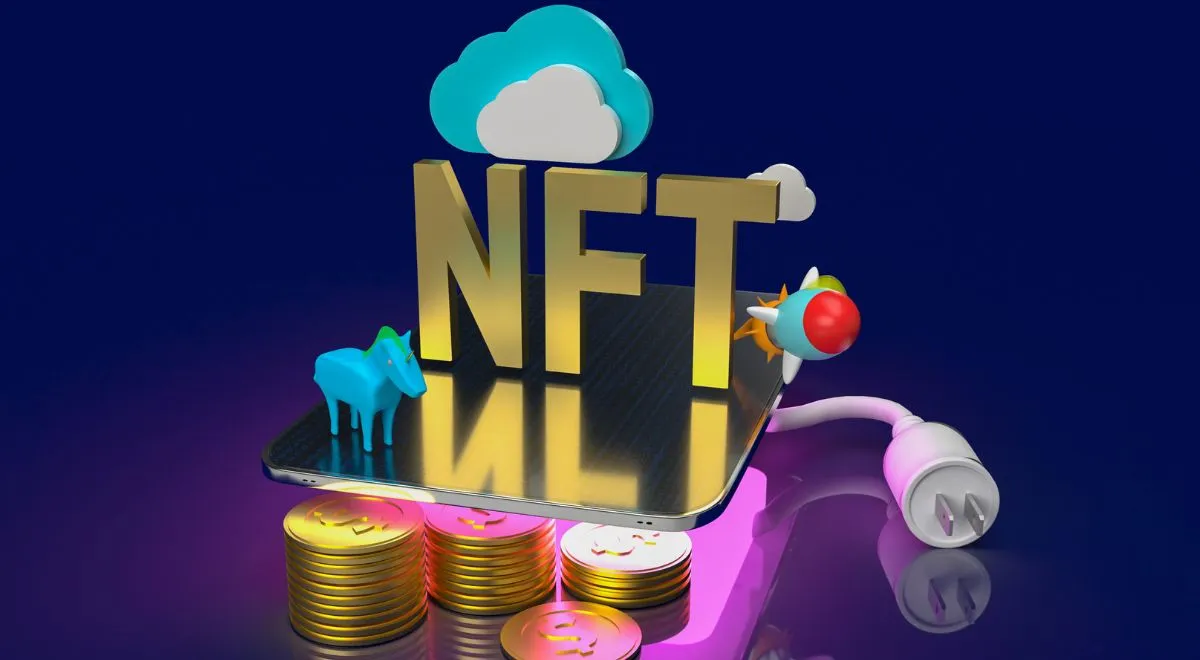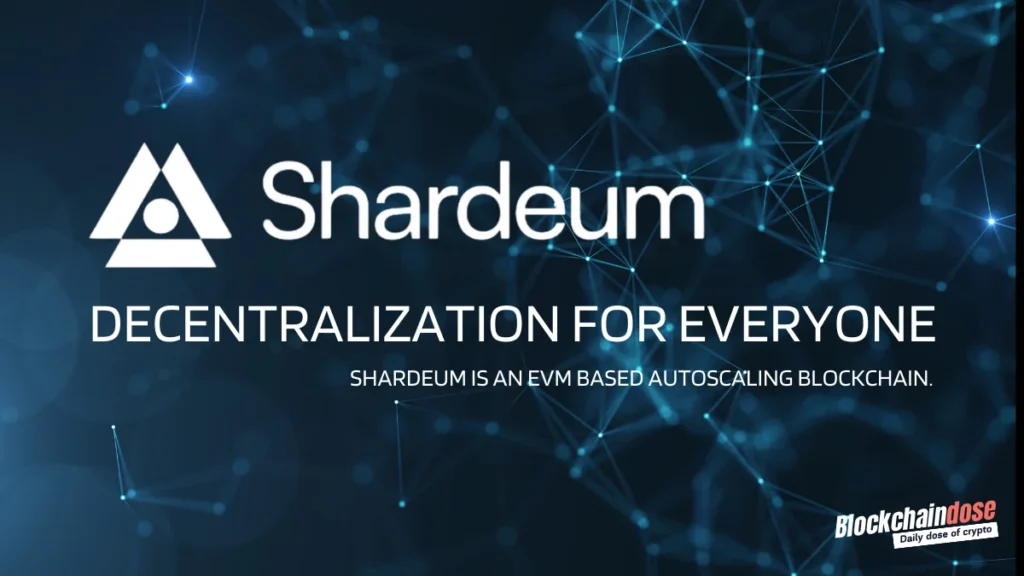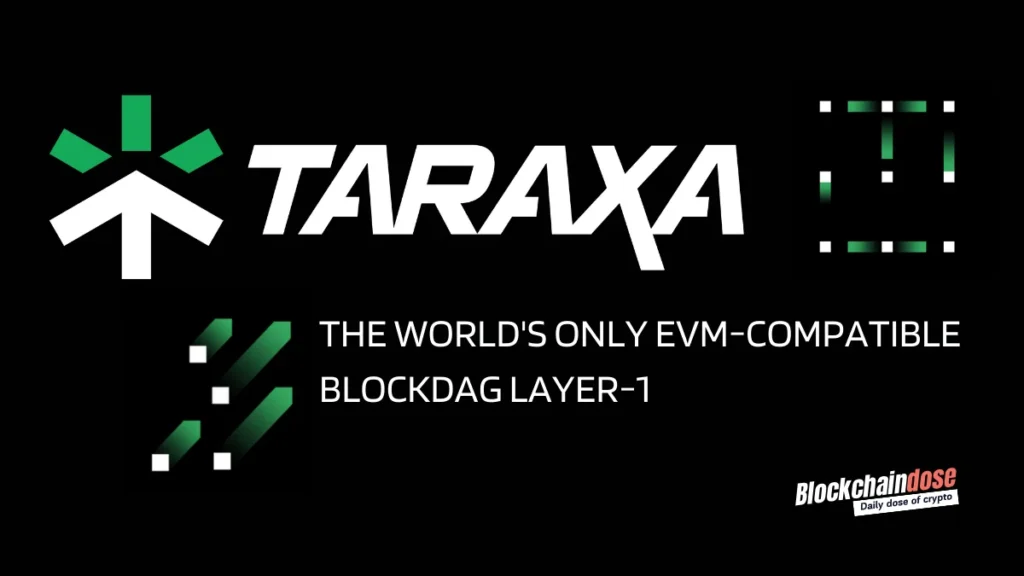Ever heard of the saying, “every great journey begins with a single step?” For large NFT creators, that first and single step is NFT minting!
You have likely heard about NFTs on social networks and success stories of artists making fortunes overnight through NFT minting. But what does minting mean in crypto, and how does it blend with NFTs?
The term minted, or minting, may sometimes sound too technical, but it’s the key to creating non-fungible tokens. This guide digs deep into NFT minting, explaining everything, including how to make your NFTs.
Understanding NFTs
Before diving into the minting NFT process, let’s briefly understand what NFTs are. NFTs are unique digital tokens that represent ownership or proof of authenticity of a specific digital asset. These assets can include digital art, music, videos, virtual real estate, and more. Each NFT is stored on a blockchain, providing a transparent and secure ledger of ownership.

What Is NFT Minting?
In the simplest of terms, NFT minting is the process of creating and later publishing a unique token on a blockchain network. In traditional finance, the term mint refers to making new coins.
When minting an NFT, you register a digital file on the blockchain, be it art, music, PDF, or even video, linking it forever to a specific owner. This creates an immutable record of the digital asset’s existence.
So, minting an NFT is simply creating an NFT.
On minting, the digital asset can be bought and sold, with records of its transactions permanently stored on the blockchain. It is traded almost like physical artwork and collectibles; only its movement is through blockchain, and its storage is in wallets.
To break it down further, NFT minting entails the transformation of a digital file by simply publishing it on the blockchain. Once minted, the NFT enjoys the following critical attributes:
- Uniqueness: The minting process leads to a one-of-a-kind asset fashioned to prove an asset’s authenticity. The uniqueness bolsters scarcity.
- Proof of ownership: Minting also leaves the transaction record on the blockchain, proving the creator’s ownership.
- Tokenization: On minting, the NFTs become tradable on marketplaces.
Let’s say you have a piece of art. You can upload it to NFT marketplaces and mint an NFT linked to your wallet. You can then trade it out on the platform.
How Does NFT Minting Work?
Minting NFTs is more challenging than described above. It involves several steps, serious research, and proper tool selection. Below is a short step-by-step guide on NFT minting works:
Step 1: Choose a Blockchain and Minting Site
Which blockchain do you want your NFT to call home?
There are many blockchains offering homes for non-fungible tokens, including major ones like Ethereum, Solana, Cardano, and even Bitcoin. You must research and select the one that suits your needs.
Like blockchains, myriad platforms boast competence in offering NFT minting services. But not many provide top-notch services. Hence, you must screen all platforms and pick the one that works.
Also, read: Top NFT Minting Platforms of 2024
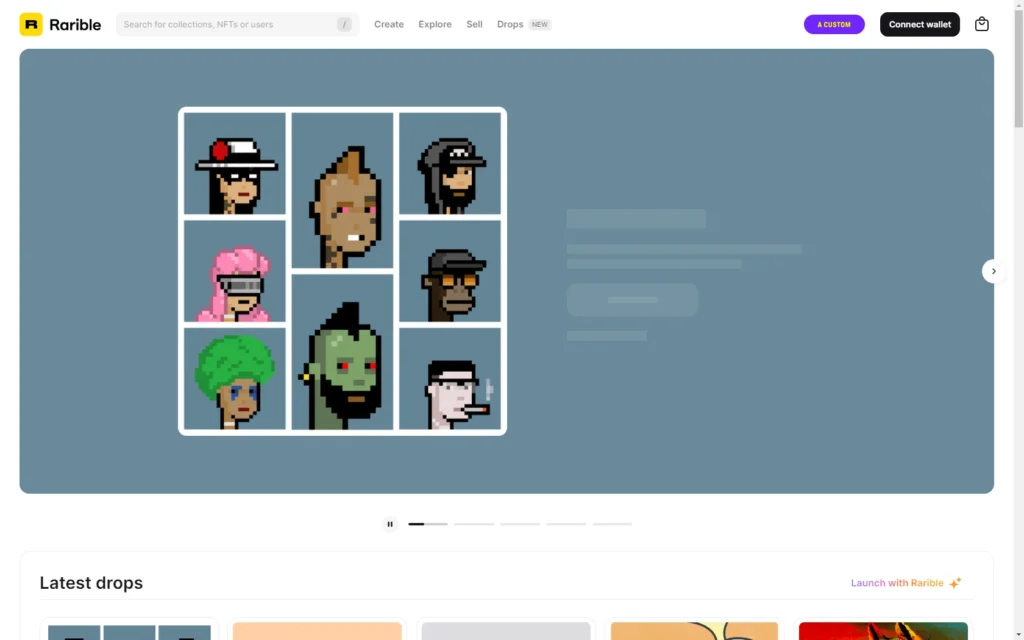
For our guide, we will use the Ethereum blockchain and Rarible marketplace. However, other viable marketplaces include:
- OpenSea
- Magic Eden
- Binance NFT Marketplace
- Known Origin
- Zora
- Crypto.com NFT
Step 2: Create a Digital Wallet: MetaMask
Second, you need a digital wallet. A crypto wallet is one of the most vital components in the crypto space and is needed for almost every asset transfer and storage.
You must also select a good digital wallet from the many options available, including Metamask, Trust Wallet, and Coinbase Wallet.
We will use MetaMask, the most popular Web3 wallet, for our article.
Step 3: Connect MetaMask Wallet to Rarible
You need to connect your MetaMask wallet to the Rarible Walle here. To do so, click the top right corner of the Rarible home page, specifically the Connect Wallet Icon.
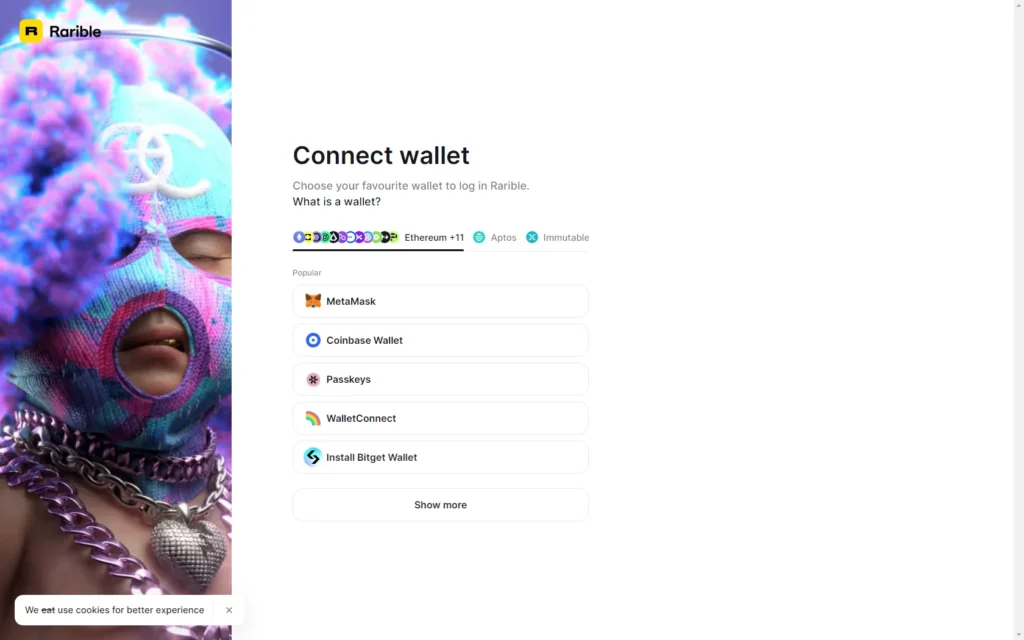
You will see multiple wallets from which to choose. Select Metamask from the popup box.
Deal with the series of confirmations.
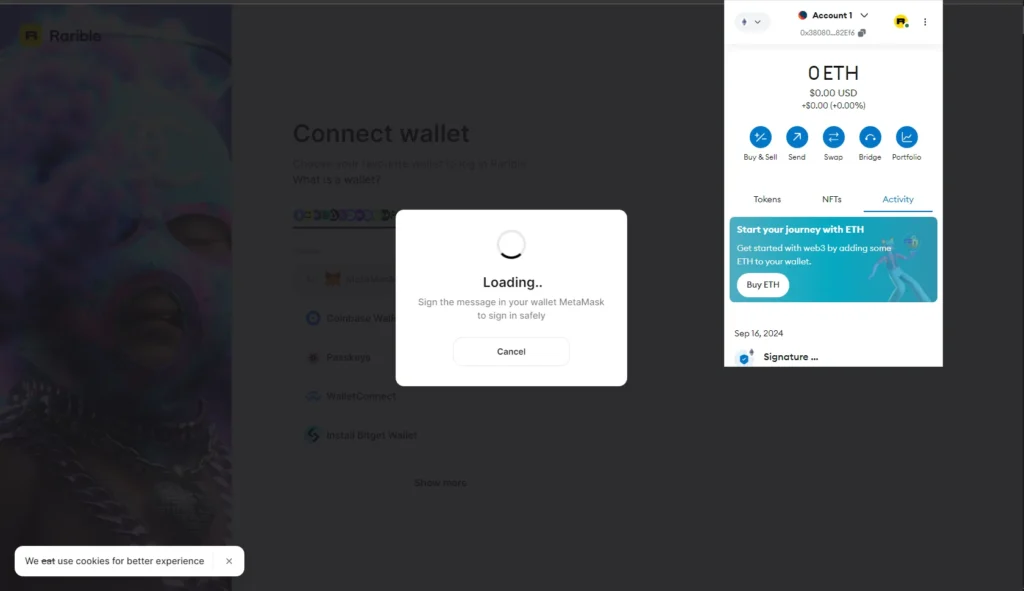
There you are— The wallet is now connected to Rarible.
Step 4: Click Create to Begin The Minting Process
Return to the Rarible home page, toggle the create button, and click NFT. A new page will open, requiring you to select a blockchain to work with.

Select Ethereum blockchain and click on it.
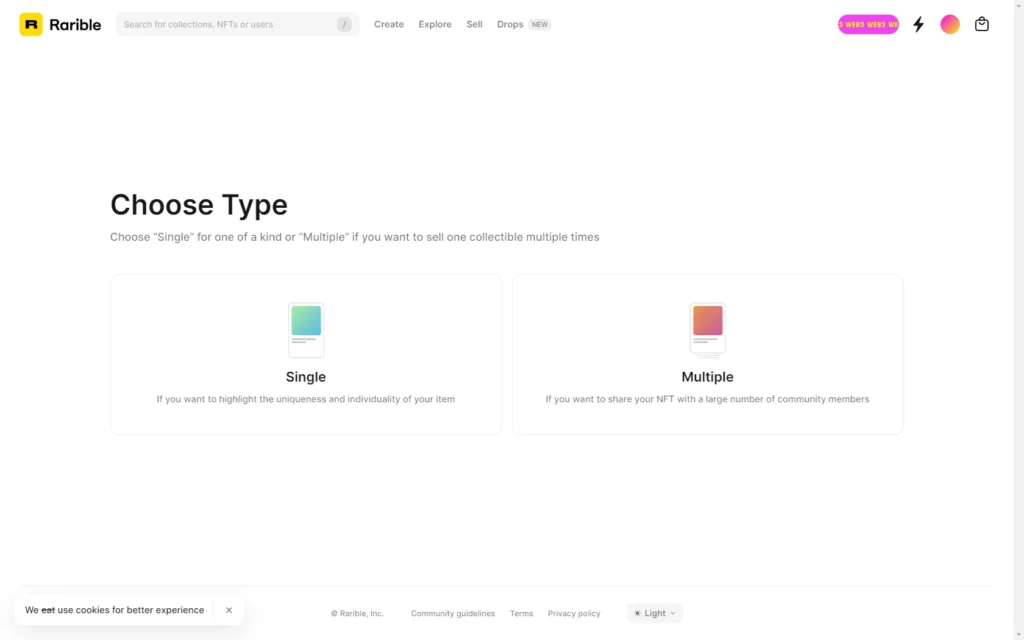
A new page asks you to choose the type of NFT you want to create, be it ‘Single’ for a one-of-a-kind or ‘Multiple’ for many almost similar NFTs.
For our case, click ‘Single,’ and a new page opens.

On the new page, you must upload the digital file you want to use to create an NFT. Note that our guide uses a random image to learn.
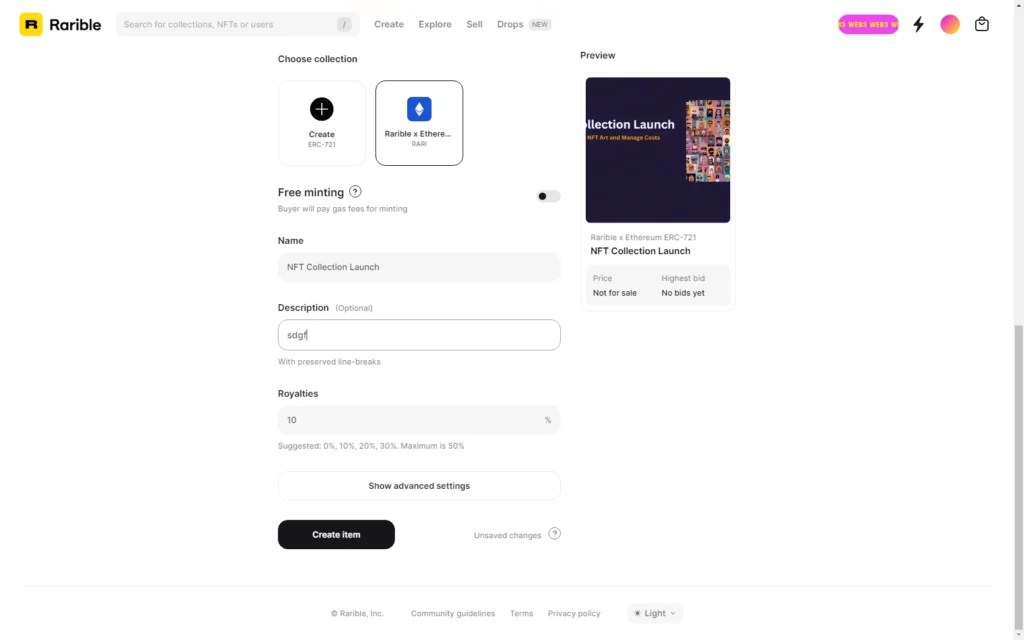
Fill in the details on the price of your NFT, and Rarible will autonomously calculate the fee to be charged. In the case above, the network charges a 7.5% fee.
Step 5: Choose Between Minting Right Away or Free Minting
Scrolling down, you will find the ‘Free Minting’ option, also known in the market as lazy minting. This involves creating the NFT but only minting on the chain once a buyer purchases it. The buyer is the one to complete the minting.
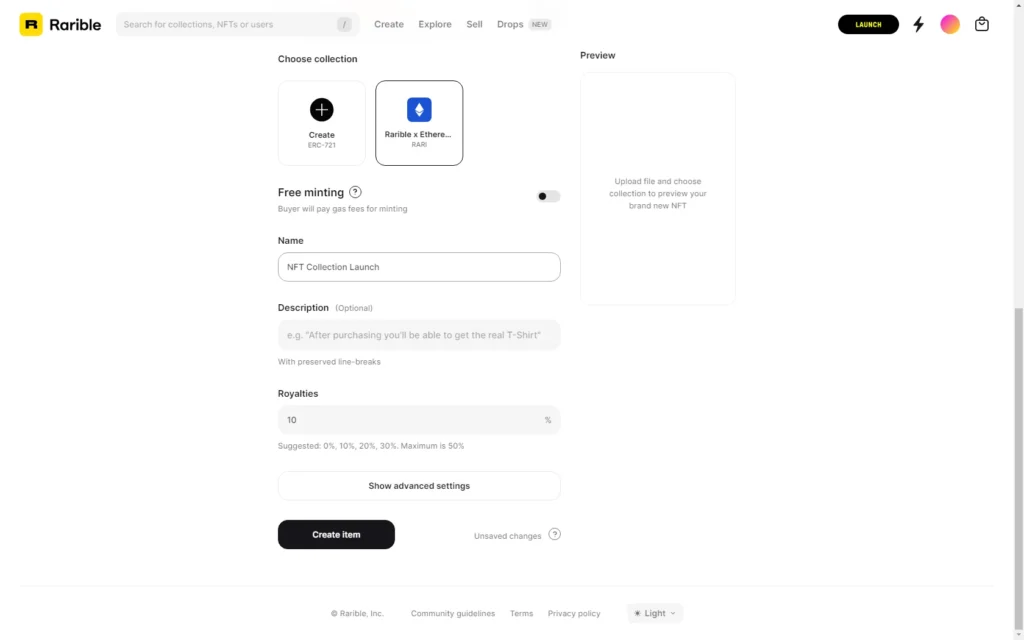
Also, read: What is NFT Gas Fees?
You can click the ‘Free Minting’ button to leave the minting works to the buyer or just mint immediately.
Step 6: Create Item
Please fill in any other necessary details, including the name, description, royalties, and date of listing expiration, and click ‘Create Item.’
What ensues is a short process of confirming the NFT creations.
Promote and Sell Your NFTs:
Minting NFT is just the beginning. To make your NFTs successful, consider
- Promote your NFTs through social media and collaborations
- Engage with your audience and share the story behind your creations
- Explore opportunities for virtual exhibitions or partnerships in the NFT space.
Free NFT Minting: What Is It?
In step 5 above, our guide lightly touched on free NFT minting, also known as lazy minting. Free minting involves minting NFTs without paying the upfront fees to publish the asset on the blockchain.
In a conventional sense, when creators mint an NFT, they must cover the gas charges associated with them. This means they will pay the gas for publishing the asset on-chain.
However, in free/lazy minting, the NFTs are first created and listed on the marketplace without publishing on the chain. Later, when the creator sells the NFT, the buyer pays for the minting costs, and the NFT is published on the chain.
Free Mint NFTs Concept comes with the following advantages:
- No upfront costs in NFT creation
- Ease of accessibility for the services, especially for beginner NFT creators.
- Listing NFTs with almost zero risk involved.
While there is a world of benefits in minting NFTs, there also come a few drawbacks, including:
- While the fees are not paid at creation, they will still be paid later.
- Market perception could reduce the marketability of the NFTs
- The creator has less control over their NFT being recorded on a chain.
What Are The Benefits of Minting an NFT?
After understanding the concept of NFT minting, another question looms: what benefits do we get from minting those assets?
NFT minting holds immense significance, with massive popularity in various industries, including music, gaming, and more. Here are the perks broken down:
Ownership and Authenticity
Many investors have entered the world of NFT minting to assure ownership and authenticity. Remember, in the digital realm, files can be copied and distributed endlessly, making it nearly impossible to verify their authenticity.
With NFT, it is possible to prove ownership and authenticity of a particular file. When minting, you create an unalterable digital token linked permanently to the asset. The ownership is easily verifiable on blockchain and, hence, indisputable.
You can also trace the origin of the creation through the blockchain, meaning you can distinguish between a sham and an actual copy.
Scarcity and Value
Value and scarcity are two factors that are directly related to collectibles. Higher scarcity almost always means higher demand, hence high value.
NFT creators often opt for limited supply. This means there are only very few almost similar copies of an NFT. If there are few copies, the asset gains more value. Scarcity also means that a particular NFT is unique or exclusive, hence generally more appealing to collectors.
Monetization for Creators
The rise of NFTs also brought new revenue streams for game developers, musicians, and creators. Now, creators can directly sell their work to buyers, bypassing all middle parties like record labels, publishers, and galleries, which take a share of the profits.
Moreover, in most NFT marketplaces, the artists enjoy the value of their creations even after selling them. Some platforms offer royalties over 10% of sale-on values, meaning perpetual profits for the creators.
What’s In Store for NFT Minting
The recent growth in the NFT space, especially the buzz since 2021, has led to massive evolutions and emerging and adopting new trends. One of the most popular recent evolutions is Layer 2 solutions. L2 solutions, specially built to run on blockchain networks, bolster scalability and reduce gas charges.
Aside from the growth in L2s like Polygon, blockchains like Solana and Tezos have emerged, boasting more efficiency in NFT minting. The free or lazy minting trend is another invention that has reshaped NFT creation. Everyone can participate with zero fear of the upfront costs.
The conceptualization of dynamic and programmable NFTs leaves the NFT minting space with more fields to expand. Creating NFTs capable of change or evolution means the assets can be used in gaming, virtual worlds, and more.
NFT fractionalization, where an NFT is divided into smaller tradable pieces, is also a trend awaiting further exploration. Fractional ownership of NFTs essentially redefines how we perceive and trade valuable NFTs, offering a new layer of liquidity and accessibility to the market.
Learn, more: Is taking screenshot of NFT legal?
Conclusion: NFT Minting
Our guide focused mainly on NFT minting and how the process works. From blockchain selection to the actual minting, the guide gave a clear outline for rookies to follow.
If you are launching a test NFT asset to see how the market reacts, you can opt for the free or lazy minting option, where the costs are paid way later. However, if you want to maintain complete control over when your asset is published on the chain, then you can use the traditional minting option.
Ultimately, every creator aims for quick adoption, great value, and royalties in perpetuity.
FAQ – Frequently Asked Questions
Minting an NFT means creating a unique digital asset and recording it on a blockchain. This process transforms a digital file into a one-of-a-kind token with verifiable ownership and authenticity, allowing it to be bought, sold, or traded in the NFT marketplace.
While some platforms offer “lazy minting” options that defer gas fees until the NFT is sold, truly free NFT minting is rare. However, some platforms occasionally run promotions or use layer-2 solutions that can significantly reduce or eliminate upfront minting costs for creators.
Some of the best NFT minting websites include OpenSea, Rarible, and Mintable for their user-friendly interfaces and large marketplaces. For more curated experiences, platforms like Foundation and SuperRare are popular among artists, while game-specific platforms like NBA Top Shot cater to niche markets.
